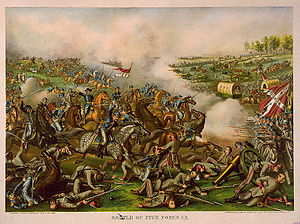Battle of Five Forks
| Battle of Five Forks | |||||||
|---|---|---|---|---|---|---|---|
| Part of the American Civil War | |||||||
 Sheridan's charge at Five Forks (lithograph published c.1886) |
|||||||
|
|||||||
| Belligerents | |||||||
|
|
|
||||||
| Commanders and leaders | |||||||
| Philip H. Sheridan | George E. Pickett | ||||||
| Units involved | |||||||
| V Corps | Units from Army of Northern Virginia | ||||||
| Strength | |||||||
| 22,000 | 10,600 | ||||||
| Casualties and losses | |||||||
| 830 | 2,950 | ||||||
The Battle of Five Forks was fought on April 1, 1865, southwest of Petersburg, Virginia, around the road junction of Five Forks, Dinwiddie County, Virginia, during the end of the Richmond–Petersburg Campaign (sometimes called the Siege of Petersburg) and in the beginning stage of the Appomattox Campaign near the conclusion of the American Civil War. A mobile task force of combined infantry, artillery and cavalry from the Union Army commanded by Major General Philip Sheridan defeated a Confederate States Army combined task force from the Army of Northern Virginia commanded by Major General George E. Pickett. The Union force inflicted over 1,000 casualties on the Confederates and took between 2,400 and 4,000 prisoners while seizing Five Forks, the key to control of the South Side Railroad (sometimes shown as Southside Railroad), a vital Confederate supply line to, and retreat line from, Petersburg.
The battle was immediately preceded by two battles on March 31, 1865. At the Battle of White Oak Road, infantry of the Union Army's V Corps of the Army of the Potomac pushed back the main line of Confederate defenses on the right flank of the Army of Northern Virginia southwest of Petersburg. The V Corps blocked two important roads as well as taking a better position for an attack on the Confederate line. At the Battle of Dinwiddie Court House, Sheridan's cavalry tactically lost a battle to Pickett's combined force but had fewer casualties and averted being dispersed or forced to retreat from the area. At nightfall, Sheridan's troopers still held a defensive line 0.75 miles (1.21 km) north of Dinwiddie Court House.
...
Wikipedia
